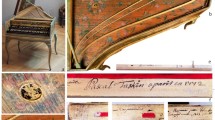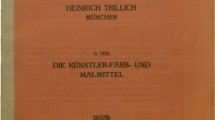Abstract
The study of varnishes from musical instruments presents the difficulty of analysing very thin layers of heterogeneous materials on samples most of which are generally brittle and difficult to prepare. Such study is crucial to the understanding of historical musical instrument varnishing practices since written sources before 1800 are very rare and not precise. Fourier-transform infrared (FTIR) spectroscopy and imaging methods were applied to identify the major chemical components within the build-up of the varnish layers on a cello made by one of the most prominent French violin-makers of the eighteenth century (Jacques Boquay, ca. 1680–1730). Two types of FTIR imaging methods were used: scanning with a synchrotron-based microscope and full-field imaging using a 2D imager with a conventional source. An interpretation of the results obtained from these studies on the Boquay cello is that the maker first applied a proteinaceous layer, probably gelatine-based animal glue. He later applied a second layer based on a mixture of a drying oil and diterpenic resin from Pinaceae sp. From an historical perspective, the results complement previous studies by describing a second technique used for musical instrument finishes at the beginning of the eighteenth century in Europe.

FTIR spectromicroscopy study of a cello made by the luthier Jacques Boquay (Paris, ca. 1680-1729) shows that the maker first applied a proteinaceous layer, probably gelatine-based animal glue.





Similar content being viewed by others
References
Echard JP, Lavedrine B (2008) Review on the characterisation of ancient stringed musical instruments varnishes and implementation of an analytical strategy. J Cult Herit 9:420–429
Latour G, Echard JP, Soulier B, Emond I, Vaiedelich S, Elias M (2009) Structural and optical properties of wood and wood finishes studied using optical coherence tomography: application to an 18th century Italian violin. Appl Opt 48(33):6485–91
Echard JP, Bertrand L (2010) Complementary spectroscopic analyses of varnishes of historical musical instruments. Spectrosc Eur 22(2):12–15
Echard JP, Cotte M, Dooryhée E, Bertrand L (2008) Insights into the varnishes of historical musical instruments using synchrotron micro-analytical methods. Appl Phys A 92(1):77–81
Bartoll J, Hahn O, Schade U (2008) Application of synchrotron infrared radiation in the study of organic coatings in cross-sections. Stud Conserv 53(1):1–8
Spring M, Ricci C, Peggie DA, Kazarian SG (2008) ATR-FTIR imaging for the analysis of organic materials in paint cross sections: case studies on paint samples from the National Gallery, London. Anal Bioanal Chem 392(1–2):37–45
Cotte M, Dumas P, Taniguchi Y, Checroun E, Walter P, Susini J (2009) Recent applications and current trends in cultural heritage science using synchrotron-based Fourier transform infrared micro-spectroscopy. C R Physique 10(7):590–600
Gruchow F, Machill S, Thiele S, Herm C, Salzer R (2009) Imaging FTIR spectroscopic investigations of wood: paint interface of aged polychrome art objects. e-Preserv Sci 6:145–150
Joseph E, Prati S, Sciutto G, Ioele M, Santopadre P, Mazzeo R (2010) Performance evaluation of mapping and linear imaging FTIR microspectroscopy for the characterisation of paint cross sections. Anal Bioanal Chem 396(2):899–910
Levenson E, Lerch P, Martin MC (2006) Infrared imaging: synchrotrons vs arrays, resolution vs speed. Infrared Phys Technol 49:45–52
Miller LM, Smith RJ (2005) Synchrotrons versus globars, point-detectors versus focal plane arrays: selecting the best source and detector for specific infrared microspectroscopy and imaging applications. Vib Spectrosc 38:237–240
Salzer R, Siesler HW (2009) Infrared and Raman spectroscopic imaging. Wiley, Weinheim
Milliot S (1997) Histoire de la Lutherie Parisienne. Tome 2: les Luthiers du 18e siècle. Les Amis de la Musique
Chen H, Ferrari C, Angiuli M, Yao J, Raspi C, Bramanti E (2010) Qualitative and quantitative analysis of wood samples by Fourier transform infrared spectroscopy and multivariate analysis. Carbohydr Polym 82(3):772–778
R Development Core Team (2008) R: a language and environment for statistical computing. R Foundation for Statistical Computing, Vienna. ISBN 3-900051-07-0
Ward JH (1963) Hierachical grouping to optimize an objective function. J Am Stat Assoc 58:236–244
Echard JP, Bertrand L, von Bohlen A, Le Hô AS, Paris C, Bellot-Gurlet L, Soulier B, Lattuati-Derieux A, Thao S, Robinet L, Lavédrine B, Vaiedelich S (2010) Nature of the extraordinary finish of Stradivari’s instruments. Angew Chem Int Ed 49(1):197–201
Derieux A, Rochut S, Papillon MC, Pepe C (2001) Identification des colles protéiques présentes dans les œuvres d’art par couplage CG/SM à trappe d’ions. C R Chimie 4(4):295–300
Echard JP, Benoit C, Peris-Vicente J, Malecki V, Gimeno-Adelantado JV, Vaiedelich S (2007) Gas chromatography/mass spectrometry characterization of historical varnishes of ancient Italian lutes and violin. Anal Chim Acta 584(1):172–180
Echard JP, Vaiedelich S. (2008) Quelques résultats d’analyses chimiques sur des vernis d’instruments d’Antonio Stradivari. De la peinture de chevalet à l’instrument de musique: vernis, liants et couleurs, 6–7 mars 2007, Cité de la musique, Paris, 104–113
Byler DM, Susi H (1986) Examination of the secondary structure of proteins by deconvolved FTIR spectra. Biopolymers 25(3):469–487
Payne KJ, Veis A (1988) Fourier transform IR spectroscopy of collagen and gelatin solutions: deconvolution of the amide I band for conformational studies. Biopolymers 27:1749–1760
Rivenc R, Phenix A, Singer B, Balcar N (2008) L’élimination des vernis huile-résine. Première partie : huile de lin et colophane, Cité de la Musique, Paris, 89–101
Meilunas RJ, Bentsen JG, Steinberg A (1990) Analysis of aged paint binders by FTIR spectroscopy. Stud Conserv 35(1):33–51
Scalarone D, Lazzari M, Chiantore O (2002) Ageing behaviour and pyrolytic characterisation of diterpenic resins used as art materials: colophony and Venice turpentine. J Anal Appl Pyrolysis 64:345–361
Scalarone D, Lazzari M, Chiantore O (2003) Ageing behaviour and analytical pyrolysis characterisation of diterpenic resins used as art materials: Manila copal and sandarac. J Anal Appl Pyrolysis 68–69:115–136
Levenson E, Lerch P, Martin MC (2008) Spatial resolution limits for synchrotron-based spectromicroscopy in the mid- and near-infrared. J Synchrotron Radiat 15:323–328
Nadolski LS, Besson JC, Bouvet F, Brunelle P, Cassinari L, Denard JC, Filhol JM, Hubert N, Lamarre JF, Loulergue A, Nadji A, Pedeau D, Tordeux MA (2008) Orbit stability status and improvement at soleil. Proc EPAC08, Genoa, Italy, 3134-3136
Acknowledgements
We thank D. Jaillard (CCME, Orsay) and M.-A. Languille (IPANEMA, SOLEIL) for sample ultra-microtomy, A. von Bohlen for SEM/EDX (ISAS, Dortmund), C. Egasse and S. Thao-Heu (CRCC, Paris) for performing chromatographic analyses, E. Quirico (LPG, UMR5109 CNRS, Grenoble) for full-field FTIR imaging analyses, P. Dumas (SMIS beamline, SOLEIL) and P. Cook (IPANEMA, SOLEIL) for their critical reading of the manuscript and M.-A. Tordeux (SOLEIL) for interesting discussions on the stability of the SOLEIL source. Specific additional funding was provided by Cité de la musique, the SOLEIL synchrotron and the French Ministry of Culture.
Author information
Authors and Affiliations
Corresponding author
Additional information
Published in the special issue Analytical Chemistry for Cultural Heritage with Guest Editors Rocco Mazzeo, Silvia Prati, and Aldo Roda.
Electronic supplementary material
Below is the link to the electronic supplementary material.
Rights and permissions
About this article
Cite this article
Bertrand, L., Robinet, L., Cohen, S.X. et al. Identification of the finishing technique of an early eighteenth century musical instrument using FTIR spectromicroscopy. Anal Bioanal Chem 399, 3025–3032 (2011). https://doi.org/10.1007/s00216-010-4288-1
Received:
Revised:
Accepted:
Published:
Issue Date:
DOI: https://doi.org/10.1007/s00216-010-4288-1




